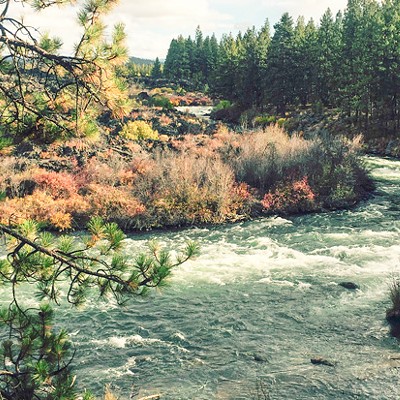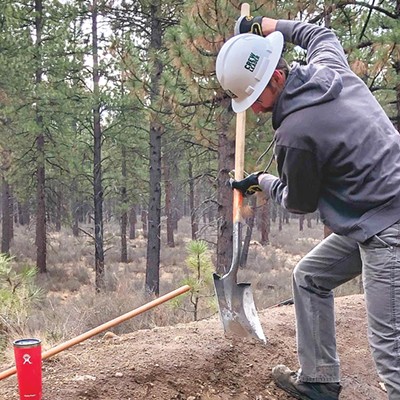At last Wednesday's city council meeting, Mayor Jim Clinton held up a colorful painting of what could be. The rendering (pictured above) showed both a river and a pond—but no Newport Avenue dam, the 103-year-old, leaking structure that creates Mirror Pond.
Presented to murmuring approvals and head nods at the city council meeting, this new idea is the latest wrinkle in the ongoing debate.
And, what may seem at first blush, a silly can't-we-all-get-along hybrid (do we call it a rond, or a piver?), the river-and-pond idea is gaining popularity as a viable solution for the vexing problem that surrounds Mirror Pond, its dam and the silt-filled waters behind it. Ever since Wednesday's city council meeting, that consensus-finding concept artwork has gained significant traction on social media sites and among various local organizations and clubs. It has also captured the imagination of more than a few locals and elected officials.
"I think it's very, very attractive," said city councilor Victor Chudowsky of the river-and-pond painting. "Frankly, the more we look at the (Newport Avenue) dam, the more problematic it becomes," he added. Chudowsky also sits on the Mirror Pond Ad Hoc Work Group, a committee charged with providing direction to the city and the Bend Park & Recreation District.
Pacific Power owns the aging dam, but in late November, representatives from the utility company announced they were ready to divest their interests in the ailing structure. The announcement to ditch the dam wasn't a complete surprise; just a month earlier, a new breach was discovered in one of the dam's wooden bays—the third such breach in five years. Plus, the dam is hardly a revenue-generator, providing only enough power for a few hundred homes.
Meanwhile, city and park district representatives remain locked in tense negotiations with Pacific Power officials in hopes of finding an amendable way in which the utility company could unload the dam and still please the city and its citizens. But deciding the dam's ultimate fate, and that of Mirror Pond, still seems a long way off—especially when any solution, whether eliminating the dam or purchasing it outright, will likely cost millions.
As the debate rambles on, a few local groups, like the Bend Paddle Trail Alliance, an area recreation and conservation nonprofit, have decided to get off the sidelines and into the river-versus-pond game. Although BPTA has yet to take an official stance, it was BPTA members who put forward the suggested hybrid river-and-pond concept at Wednesday's city council meeting. They're pushing for what they call a win-win solution—one that unites rather than divides, and one that promises economic development and increased recreational opportunities.
"So far, everyone has been working against each other," said Jayson Bowerman, a BPTA board member and area kayaker. "It will take all of us working together to get this done."
The concept is simple: provide something for everyone, and in the most economical way possible.
The proposal is to do away with the failing Newport Avenue dam. By simply telling Pacific Power, "Thanks, but no thanks," the utility company would be responsible for decommissioning and removing the current dam as well as covering associated habitat restoration costs. In place of the Newport Avenue Dam, a new structure would be built upstream—possibly a bladder dam or weir, or perhaps something similar to the one planned for the Colorado Dam safe passage site even further upstream. Such a feature could, depending on the season, be manipulated to allow more or less river water to flow past it, all while allowing for fish passage. And the moving water would help flush silt downstream, Bowerman explained.
By creating this new structure, a version of Mirror Pond would remain, albeit one that doesn't stretch all the way to the Newport Avenue Bridge. And without the impediment of the Newport Avenue dam, all the segments of the Deschutes River Trail could finally be fully connected. The concept solution, it seems, would be a boon for fish and river habitat, nostalgic neighbors, environmentalists and river recreationalists.
Another clever aspect of the river-and-pond concept is that by running a small pipe from the pond to the current powerhouse, the city could create a micro-hydro option. Popular in Europe, the green energy solution would also serve as a work-around for the water rights issue associated with the Newport Avenue dam. As it stands today, the water right only allows water storage (the water that creates Mirror Pond) for power-generating purposes, though a park district attorney did suggest seeking a legislative exemption to the state rule.
"It's a totally legit concept and worth exploration," said Ryan Houston, executive director of the Upper Deschutes Watershed Council, of the river-and-pond concept. Houston has been involved with a number of dam removals and habitat restoration efforts. But, Houston said, the hybrid solution still presents a number of sticking points, such as possible silt accumulation.
"I think if Pacific Power is going to remove the dam, the absolute cheapest thing for the community is to let them do it," Houston added.







![Environmental Watchdog: Central Oregon LandWatch Executive Director Ben Gordon 🎧 [with podcast]](https://media2.bendsource.com/bend/imager/environmental-watchdog-central-oregon-landwatch-executive-director-ben-gordon-with-podcast/u/r-bigsquare/12803856/bend-don_t-break-promo-slider.jpg?cb=1680199462)





















